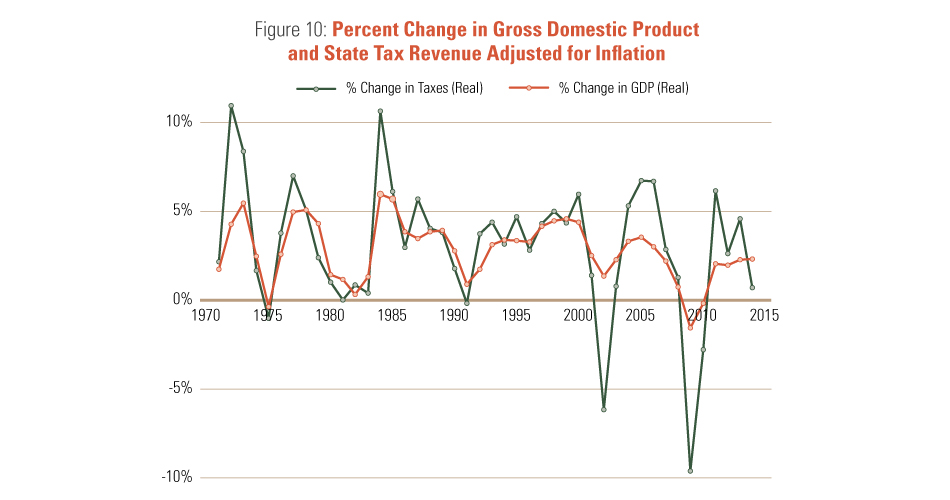Section 4: Looking Forward: Prospects for the Future
States’ potential to provide support for higher education depends crucially on tax revenue. Unfortunately, state tax revenue has remained weak: seven years after the start of the recession, inflation-adjusted state government tax revenue is only 5 percent above its prerecession level. By contrast, in four preceding economic recoveries, state tax revenue had grown from 15 to 25 percent above prerecession revenue in the same amount of time.21
The outlook for tax revenue growth is subdued. Most major economic forecasters expect that the national economy will continue to improve throughout 2015 and 2016, inflation will be low but will gradually rise, and interest rates will rise slightly.22

|
State taxes are more volatile than the economy and more volatile than they used to be. Note: Years are twelve-month periods ending in June, corresponding to the fiscal year of the typical state budgetary office. Source: Analysis of data from the United States Census Bureau, http://www.census.gov/; and U.S. Department of Commerce, Bureau of Economic Analysis, http://www.bea.gov/.
State income taxes and sales taxes accounted for 35.9 percent and 31.3 percent, respectively, of state tax revenue in fiscal year 2014. Income taxes are unlikely to grow much faster than the overall economy over the next several years: progressive tax structures will drive growth up slightly, but this will likely be offset by drag from slow growth in nonwage income. Sales taxes have grown more slowly than the economy for more than forty years.23 This is a result of the difficulty in taxing the service industry and in collecting taxes on Internet sales, among other causes. The sales tax is likely to continue to grow more slowly than the economy for years to come. Thus, the overall outlook is for relatively slow revenue growth in the two major tax sources for the typical state.24
ENDNOTES
21 Boyd and Dadayan, The Economy Recovers While State Finances Lag.
22 For surveys of major forecasters, see The Wall Street Journal, “Economic Forecasting Survey,” http://projects.wsj.com/econforecast/; and Federal Reserve Bank of Philadelphia, “Survey of Professional Forecasters,” http://www.philadelphiafed.org/research-and-data/real-time-center/survey-of-professional-forecasters/. For the latest forecasts available at the time of writing, see The Wall Street Journal, “WSJ Economic Survey June 2015,” http://online.wsj.com/public/resources/documents/wsjecon0615.xls. See also Boyd and Dadayan, The Economy Recovers While State Finances Lag.
23 John L. Mikesell, “The Disappearing Retail Sales Tax,” State Tax Notes (March 5, 2012): 777–791.
24 Boyd and Dadayan, The Economy Recovers While State Finances Lag.